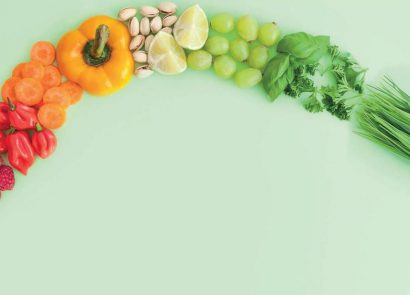Struggling to get your five-a-day? We hear you. Here’s how to up your fruit and veg intake without even realising
It’s safe to say that, after the challenges we faced during 2020, many of us haven’t been eating the healthiest foods we can over the past year. Whether it’s been weeknight takeaways to brighten up those dark nights, or choosing a biscuit over a banana to get you through WFH at your kitchen table, it can be hard to eat enough of the foods we should be eating, namely fruit and veg. In fact, in a YouGov survey of more than 2,000 people, commissioned by the British Nutrition Foundation, 27 percent admitted that they were eating less healthily than they had been before the pandemic, and almost half did not feel ‘motivated’ enough to eat well. If this is you, listen up. We’ve rounded up easy ways to squeeze more fruit and veg into every meal, without the hassle – you’re welcome!
Brighten up breakfast
Forget grabbing a piece of toast on your way out the door (or en route to your makeshift office), you can make breakfast a nutritious feast with just a few small tweaks. “Breakfast is the first and most important meal of the day, so getting in your first portion of fruit and vegetables is a great way to get ready for the day ahead,” says David Wiener, nutritionist for Sankofa Snacks (sankofasnacks.com). “Creating tasty smoothies with fruits and vegetables is a really easy way to pack in your five-a-day without even realising, especially leafy greens like kale. However, many of us add fruit juice to our smoothies which can often contain high sugar levels, so instead swap your sugary fruit juice for coconut water or low-fat yoghurt. Alternatively, overnight oats or yoghurt bowls can be topped with fresh or frozen fruit. Adding fibre-rich ingredients, such as raspberries and strawberries, along with protein from the yoghurt or the oats, will also help you to feel satisfied for longer.”
Not got a sweet tooth? “If you’re more of a savoury breakfast person, you could add tomatoes, mushrooms, avocado or spinach to your usual choice,” says dietitian Sophie Medlin, founder of CityDietitians (citydietitians.co.uk).
Load up at lunch
Lunch doesn’t have to mean a dull meal deal, and, if you’re busy, you can do some prep in advance. “Similar to smoothies, soups are always a fantastic option for getting in loads of veggies,” says David. “Roasting a range of vegetables, such as tomatoes and sweet potatoes, and then blending them up, makes for a lovely nutritious soup which can be enjoyed throughout the week. Not only is it the perfect winter warmer, but you can get at least three of your five-a-day from one meal.” Impressive!
Another great idea for lunch is an omelette, as naturopathic nutrition coach Jessica Shand (eatnourishandglow.com) explains. “They’re quick and easy to make and so versatile! All you need is two eggs and a handful of mushrooms, spinach, tomatoes, onions and peppers, plus a pinch of salt, pepper and oregano.”
Snack time swaps
Step away from the biscuit tin and add some variety to help you get through that 3pm slump. “Why not replace ultra-processed snacks for vegetables, fruits, nuts and seeds?” asks registered nutritional therapist Marilia Chamon, trained functional medicine practitioner and founder of Gutfulness Nutrition (gutfulnessnutrition.com). “Pair sliced fruits with nut or seed butters, make vegetable dips with different types of beans or have a yoghurt bowl with some fruits, nuts and seeds.”
Kids not interested in veg? “Using different cutter shapes or a crinkle cutter can make vegetables more interesting, especially on hard varieties such as cucumber, peppers and carrots,” says registered nutritionist Laura Matthews (lauramatthewsnutrition.co.uk). “These make perfect implements for snacking on and dipping in houmous or sour cream!”
Dial up dinner
“For a lot of people, dinner is what gets them through the day,” says David. “The thought of a delicious dinner enjoyed with family is lovely, but by the time you get round to cooking, you may opt for quick, easy and cheap meals, rather than those packed with nutrition. Instead of completely changing your favourite after-work meals, swap out one ingredient from your recipe for a vegetable. For example, instead of making a bowl of pasta, try courgetti (spaghetti made from courgettes).”
You could also replace a few meat-based meals each week with plants. “Instead of your usual chicken curry ,why not swap the chicken for chickpeas and spinach or how about trying lentils instead of mincemeat the next time you make spaghetti bolognaise?” asks Jessica. “Your gut will love you for it!”
Say yes to dessert
You can even add some sneaky veg to your afters, which is particularly useful to help kids reach their fivea- day. “There are a plethora of new recipes online that entwine fruit and vegetables into our beloved desserts,” David tells us. “Think brownies with beetroot or courgette, or carrot cake that’s more carrot than cake! Baking with vegetables isn’t as unpalatable as it may seem at first. Carrot, beetroot and courgettes are fantastic binding agents that make the cakes, traybakes and tarts beautifully moist and, most importantly, can make puds healthy.”
Not sure about baking cakes with veg? “You can make a healthier version of a crumble by sprinkling some toasted granola onto stewed fruit,” suggests Sophie. “Make fruit jellies, serve stewed fruit with a scoop of ice cream or yoghurt or go back to the 80s with bananas and custard.”
Easy wins
It can be difficult, particularly in the current climate, to know how to get enough fruit and veg into your diet, but these general tips are designed to give you a helping hand.
Try frozen
According to a YouGov survey, 30 percent of participants said that not being able to go to the supermarket often had made it difficult for them to eat well, but luckily there are ways around that. One of the best ways is to opt for frozen over fresh. “Keep bags of frozen vegetables for those nights that you are short on time,” says Marilia. “Store all types and colours of canned beans in your pantry and add them to soups, stirfry, pasta and sauces, but always check the label for no added sugars.”
Plan your food shopping list
“It sounds like a lot but we should be aiming to eat 30 different plants each week,” says Jessica. “The best way to do this to ensure you’re reaching this goal is to plan ahead and write your shopping list with this in mind, so that you have a well-stocked fridge and store cupboards full of vegetables to make your meals from.”
Sign up for a fruit and veg box
“You will be encouraged to cook with different fruits and vegetables if a box of beautiful organic produce shows up at your door,” says Marilia. “And don’t forget to put them on a visible area of your fridge where you will see and remember to cook them!”
Prep ahead
“Dedicate a couple of hours to prepare for the week ahead, that will make it much easier to put a healthy meal together on busy days,” says Marilia. “Wash, chop, cook and keep the leftover raw vegetable stored in glass containers for a second batch of cooking.”
Eat salad with every main meal
“Buy bags of pre-washed mixed greens and add tomatoes, beetroot, carrots, cucumber, peppers, radishes, nuts and seeds to make a tasty salad,” says Marilia. “A delicious homemade dressing elevates your salad to restaurant level. Mix extra virgin olive oil, balsamic vinegar, Dijon mustard and a squeeze of honey and never have a boring salad again!”



















